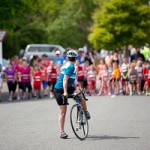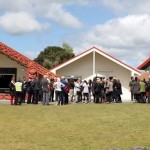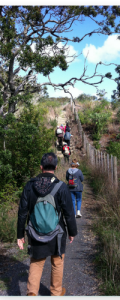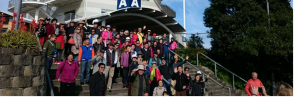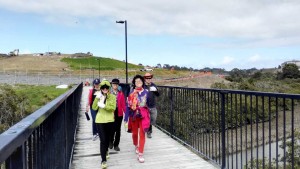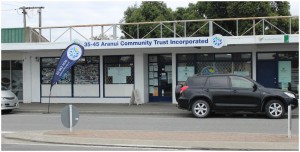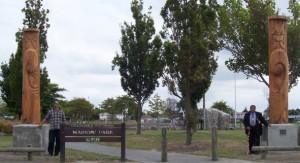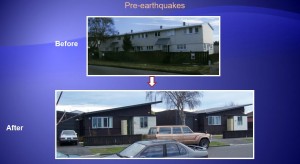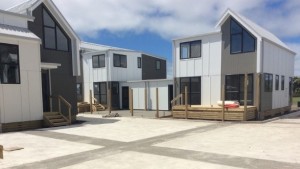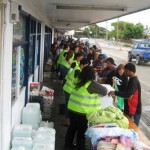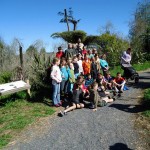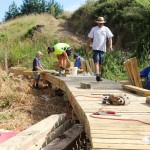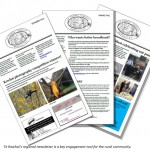My Inspiring Community – Randwick Park
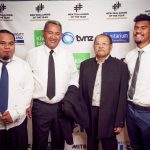 They began asking locals what would improve their place … a few years later Randwick Park has won 2017 community of the year. Maree Beaven recently talked to us about what they’ve achieved so far and how.
They began asking locals what would improve their place … a few years later Randwick Park has won 2017 community of the year. Maree Beaven recently talked to us about what they’ve achieved so far and how.
Randwick Park has also very kindly shared their story to be apart of our 2017 election manifesto please feel free to read it, and share it.
Selwyn Steps up .. and out
By Michael Wilson, Executive Officer, Selwyn Sports Trust
The Situation
In 2011 we often found asking ourselves, why? Why is Selwyn not readily recognised as a District? Why are the vast range of physical activity opportunities in Selwyn not better known? Why are Selwyn residents not catered for with ‘their own’ events? Why, why, why…
Who is involved
The ‘we’ was a group of Selwyn residents and sports enthusiasts. We had a range of experiences, involvements and ideals when it came to sport and physical activity. The thing that bound us was the pos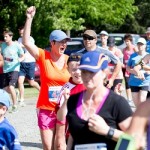 itive place we held sport and physical activity and the positive influence it had on us all. We wanted to share this with the whole Selwyn District. Selwyn Sports Trust was born from this.
itive place we held sport and physical activity and the positive influence it had on us all. We wanted to share this with the whole Selwyn District. Selwyn Sports Trust was born from this.
Well, honestly, Ellesmere Road Runners and the Selwyn Running Festival were born. Both were based out of Leeston and the community took to them. A weekly, community minded running and walking group coupled with an event that was the goal for all that regular exercise.
What we have done and how
Selwyn Sports Trust was established as we figured the support and enthusiasm shown by the Ellesmere community could be replicated Selwyn wide. The aim being to promote and support participation in sport and recreation within our District.
From humble beginnings, we have remained largely events based. Adding to our weekly running and walking groups and we’ve connected with the Malvern and Lincoln communities so we are engaging with more than 450 individuals annually.
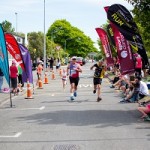 We’ve built strong relationships with other invested groups and organisations to enhance the Shoe Clinic Selwyn Running Festival. We also incorporate the Athletics Canterbury Half Marathon Championship in the Lay Associates Half Marathon, giving locals a chance to see Canterbury’s finest runners and even compete alongside them. And we’ve engaged with local businesses (McMillan Drilling Group, Oakleys Premium Fresh Vegetables and G & M Contracting) who provide more than just financial support – guidance and involvement within the Festival too.
We’ve built strong relationships with other invested groups and organisations to enhance the Shoe Clinic Selwyn Running Festival. We also incorporate the Athletics Canterbury Half Marathon Championship in the Lay Associates Half Marathon, giving locals a chance to see Canterbury’s finest runners and even compete alongside them. And we’ve engaged with local businesses (McMillan Drilling Group, Oakleys Premium Fresh Vegetables and G & M Contracting) who provide more than just financial support – guidance and involvement within the Festival too.
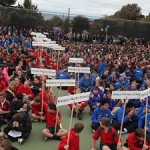 We have added two other annual events to fill gaps we identified. The Frontrunner Lake Crichton Series was a no brainer addition. Not only does this showcase the fantastic, yet largely unknown, facility – Lake Crichton, it provides first time triathletes with one of the safest ways to give the sport a go.
We have added two other annual events to fill gaps we identified. The Frontrunner Lake Crichton Series was a no brainer addition. Not only does this showcase the fantastic, yet largely unknown, facility – Lake Crichton, it provides first time triathletes with one of the safest ways to give the sport a go.
The Koru Games give South Island year 7 & 8 students an opportunity to develop their individual sporting skills while playing teams sports for their schools. There were 2000 competitors in 2016. With the support of Sport Canterbury, we will be unleashing our Physical Activity Activators on 23 Selwyn Schools from 2017.
The change we have noticed
More active communities being active together. A wider range of friendships, interactions while exercising, racing and socialising. The invisible silos within our communities have been broken down to a certain extent through people being active together, be these generational, social, gender and so on.
We hear from many of our participants that their perception of what racing is and who it is for has changed from being something for the elite and very capable and 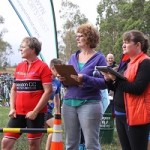 committed to something for all. We also hear that highlighting and utilising local resources and facilities is a fantastic way to show off and bring pride to the District and its residents. It’s also a great way to open the eyes of locals to what they have on their own doorstep.
committed to something for all. We also hear that highlighting and utilising local resources and facilities is a fantastic way to show off and bring pride to the District and its residents. It’s also a great way to open the eyes of locals to what they have on their own doorstep.
What we’ve learned
It has required a huge commitment from a large number of selfless individuals and organisations to begin the journey. We are very conscious of all the support and guidance we have received so far, from the individuals standing on corners during races, to those that fill out reviews to ensure we continue to cater to their needs, to the financial contributors.
We believe the initiatives and events that are the most successful are those that directly engage with their competitors and participants. Those that have clear and understood goals, vision and direction that is malleable are most successful.
We also believe that the word success has to be clearly understood. We are most definitely clear that success is not having the most participants, the largest events or making large amounts of money. It is our goal to enrich people’s lives and community well being through sport and recreation and this is how we measure success.
More info: selwynsportstrust.org.nz/
Pipiwharauroa: Hikoi for Healthy Nature
A CLD Case Study by Erena Hodgkinson , Kaiwhakapa-Storyteller, Healthy Families Far North
What’s been happening
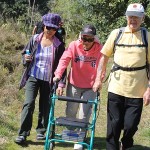 Far North iwi have heard the karanga of the pipiwharauroa and joined together in an initiative that promotes physical, emotional and community health through collaboration. In September this year, I was delighted to bear witness as Te Rarawa and Ngai Takoto joined forces for the first time with Healthy Families Far North and the Department of Conservation to lead out the Pipiwharauroa: Hikoi for Healthy Nature, Healthy People walk at the idyllic Lake Ngatu.
Far North iwi have heard the karanga of the pipiwharauroa and joined together in an initiative that promotes physical, emotional and community health through collaboration. In September this year, I was delighted to bear witness as Te Rarawa and Ngai Takoto joined forces for the first time with Healthy Families Far North and the Department of Conservation to lead out the Pipiwharauroa: Hikoi for Healthy Nature, Healthy People walk at the idyllic Lake Ngatu.
The pipiwharauroa, or shining cuckoo, is the bird that traditionally signals the start of spring and the 4km loop track provided the backdrop to celebrate both the change of season and the return of the lake to Ngai Takoto last year.
Who was involved
While the hikoi attracted community providers, it was more so the 100-plus kaumatua and kuia and local school-aged children engaging with the environment that provided the benchmark for success.
“The kaupapa is just beautiful. We had people discussing rongoa Maori along the track, we had children picking up rubbish as they walked. We had a crew dive for kuta, we heard kuia break into song. It was truly a community celebrating being a community,” says Healthy Families Far North manager Shirleyanne Brown.
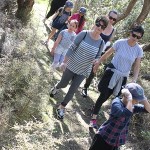 The change we are noticing and what’s enabled it
The change we are noticing and what’s enabled it
One of the huge changes to come out of Pipiwharauroa was post-settlement, inter-iwi collective impact on a positive kaupapa wrapped around hauora Maori. The hikoi set the foundations for relationships to continue to grow in strength and proved that the silo mentality can be broken where there is the will.
What we have learned
In retrospect, I see the walk as the beginnings to iwi-led development that brings together the community through an expression of kaitiakitanga for our environment, manaakitanga of each those we hold most dear – our young and our old – and aroha for both.
What happens now
Ngai Takoto have taken on host responsibility to make the hikoi an annual event and we have been approached by Ngati Kuri in the furthermost reaches of the Far North to replicate a similar initiative with the community in the North Cape area. The invitation to work with another iwi that is passionate about sharing and championing their assets is exciting and the epitome of people taking on the opportunity to connect in the most poignant way.
More info on the Healthy Families Initiative: http://www.healthyfamilies.govt.nz/
Mangakino & Whakamaru Heritage Trail
The Mangakino and Whakamaru Heritage trail has been blessed and opened (Nov 2016). When Mangakino people talked about their visions for the future during “Wow! E tū Mangakino! Let’s Dream” back in 2011, one of their community aspirations was to celebrate their area’s heritage more.
This trail is designed to link with the Waikato River Trails which attracts thousands of visitors PAST Mangakino annually – now the Heritage Trail offers them a side tour through the Townships and many memorable moments!
It’s taken a huge amount of research, persistence and patience from many people and especially Lisa, the local community broker. Recently the Mangakino community-led development group organised a community celebration for 70 years since the township was established, and blessed the new Heritage Trail – they invited everyone who had helped, along with residents of today and yesteryear. On a beautiful day at Pouakani Marae, locals, past residents and supporters gathered to enjoy and share memories, and to celebrate Mangakino.
Walk with us Albany
A CLD Case Study by Jenny Lim, Sport Capability Project Manager at Harbour Sport
The situation
The 2013 census showed that around 25% of the Upper Harbour community identified as being Asian. This is a group that is often under-represented in sport and recreation participation, and has been a community of focus for the ActivAsian project.
What we have done
In May 2016, Harbour Sport’s ActivAsian team started a small weekly walking group to provide new migrants in Albany with the opportunity to explore different walks, reserves and parks in the community. This was led initially by Shoko – our Japanese intern who initiated the group, but more recently by Tingting, who started as a volunteer Chinese interpreter for the group, and is now spearheading the project. We were excited when the first session of Walk With Us Albany attracted a group of 20 new migrants of different ethnicities – Chinese, Korean, Iranian etc. Little did we know that the group would soon grow to an average of 40 participants each week, even attracting over 20 participants on rainy days.
Who’s been involved and how?
With the group being so large, Eva, John and Lucy who were participants of the walking group stepped up and volunteered to manage the group for us, working closely with Tingting to ensure the group is safe and looked after. We also have other local groups involved – Laure, the Albany Newcomers Network Coordinator has also been a great supporter and regular participant of the group, bringing along their members, and helping with group management.
Tingting, who herself is a new migrant from China, took the initiative to not only test out each walk before walking day, but also research the history of each walk. She conducts ‘Tingting’s English class’ weekly in our WeChat group to teach English words that walkers may see on signs throughout the walk, and at the same time educating them about the environmental and historical significance of each walk. She has also led walks to the Albany bus station (teaching our new migrants about the public transport system in Auckland), QBE Stadium tour, Massey University tour, and organised indoor activities for rainy days. Each week, Tingting and our volunteers will ask for feedback from the group, and together they will plan for the following week based on this.
The change we’ve noticed
We have noticed a great improvement in the fitness of our walkers, with walks being further each week, and now a second walking day being initiated for faster walkers. There has also been a greater sense of belonging amongst the group and a stronger connection with their new community. Many of them have expressed gratitude towards Shoko and Tingting for their warmth and personal interest in ensuring the group gets a lot out of each walk.
What we’ve learned
Our coordinators’ characters and their ability to build strong positive relationships have been integral in the success of this project, and the willingness of our volunteers to go above and beyond what is expected of them to assist them. The group has really bought into the project and has made it their own. As an organisation, we have learned that our role is not to dictate what is provided to the community, but rather to act as facilitators and enablers of community driven projects. Walk With Us has been a great learning opportunity and further demonstrates that a community project can take on a life of its own when it is driven by the community.
Next steps
We are now looking to deliver two Outdoor Bush Leadership Courses to our local residents who may be interested in leading their own walks or volunteering for us. This will equip them with the skills required to safely lead walks, whether it is within their own community groups or families.
Strong relationships matter
By Rachel Fonotia – Manager Aranui Community Trust, 16th August 2016
I work for the Aranui Community Trust – I was born in Aranui, and I’m passionate about the work the Trust is doing. Our vision, “Aranui – a proud community of hope and opportunities where people stand tall – as circumstances demand” is purposefully adaptive so that we can respond to the emerging needs of our people and places. For example the focus after the earthquake in 2011, became to build a better brighter future, after the loss of our houses saw a dramatic decline in our population. We work with communities helping them identify their needs and improve their outcomes.
We’re big on improving access to health, as so many of our people are blocking up the Hospital’s Accident and Emergency with chronic conditions because of the barriers to accessing primary care. We work with education providers to improve our community’s educational outcomes as we have the highest numbers of school leavers exiting the education system without qualifications. Although we don’t concentrate on deprivation it is worth noting our community is amongst the most deprived in New Zealand. Just one example: 70% of our community don’t have communications in the house, so we still have a newsletter that is distributed to all those houses. Overcrowding is also major issue and we work tirelessly with housing providers so people can live in appropriate spaces.
While we have worked on many initiatives with the various agencies one project stands out as an example of how it can work well – and then not so much. In 2001 we entered a three way memorandum of understanding (MOU) with the Christchurch City Council and Housing New Zealand after the ageing two-storey housing stock was identified as the most unpopular, highest need issue in the community. The MOU set out how the three of us would work with the community to redevelop the spaces. The Council agreed to look at the parks and roading, Housing NZ agreed to upgrade its stock.
After the consultation Housing NZ agreed to remove the ageing stock. The community explained to them what they wanted, from single storeys to fencing. Eventually together we came up with the new houses.
Then we had an earthquake and we lost 130 of the remaining outdated stock. We worked with Housing NZ for 2 ½ years to rework what would replace those properties. They came back with a plan which involved building two storey properties again, having not noted the consultation process that had begun in 2001. In terms of design it does not work for the community.
Constantly changing personnel at agency level has been a major challenge. Promises made to keep the community involved and informed are often forgotten. Previous partnering agreements and institutional memory of community housing preferences and plans negotiated with Aranui locals have been ignored – with recently built housing developments representing everything local people said they didn’t want! The need for agencies to meaningfully work with local people and community connectors like Aranui Trust – rather than do for or to Aranui remains a work in progress. And there’s a lot going on – around $150 million is currently being invested in Aranui, ensuring local people are kept up to date with what’s planned is key.
Nobody can do doing anything on their own, we know that and we’ve been pretty smart at getting people to have the conversations at that table. We meet monthly now with the Christchurch City Council – they’ve become our friends. At different times over the 15 years, we’ve had really interesting debates, we’ve fought at the table but we have managed to come away still genuine in the outcome that we are all trying to achieve together.
What would be the point in asking our communities what they wanted and then not help them to achieve it? If we all believe we can make a difference, then we can. Our work is vital for the future of our communities.
Think local and let local do
By South Waikato Mayor, Neil Sinclair
 A truly multi-cultural District the South Waikato is right in the centre of the North Island between Hamilton Rotorua and Taupo. We are home to 23,000 people, of which about 30% are Maori and 11% Pacific Island. We are a young district, our main town, Tokoroa, was established in the 1950s when the paper mill at Kinlieth was built. Now we are 50% farming 50% forestry.
A truly multi-cultural District the South Waikato is right in the centre of the North Island between Hamilton Rotorua and Taupo. We are home to 23,000 people, of which about 30% are Maori and 11% Pacific Island. We are a young district, our main town, Tokoroa, was established in the 1950s when the paper mill at Kinlieth was built. Now we are 50% farming 50% forestry.
Yes we had a tough image, an image that unfortunately lives today. We are however a proud caring compassionate community. I know, I was a dentist for 40 years. We have the lowest crime statistics for the Bay of Plenty and my towns are almost devoid of any graffiti. But like all rural New Zealand towns we are looking at a decline in population and an aging population. We have, additionally, high youth unemployment, some poor housing stock and we are generally regarded as being a low socio economic district. It’s not an exciting picture, so why are we so confident about our district and our towns?
Councils and communities in general have to recognise their situation, accept who they are and then they can work out just what they have to do to create change. Identify your local strengths.
For us it is that we have a particularly caring, resilient community. In 2004, when I first became Mayor, through a series of circumstances I, with many others, stood on an empty section of Council land on a Thursday evening. By Sunday lunch time I was opening a children’s park on that land, with a sound shell, flying fox, BBQ, unique play equipment, swings, and a graffiti board. All done by the community. All manner of people were involved in the construction; clubs, groups, individuals, businesses, groups of people who fed us. $20,000 was raised, not a dollar from Council. Looking back now not even a resource consent! All done in 48 hours.
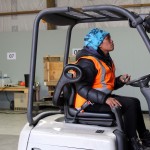 So if the community were going to be the doers then it would require an innovative, imaginative, courageous council to work with them and harness that spirit. High youth unemployment was one of the big concerns then. Council knew education was the way forward so we instituted the Mayoral Scholarship. We have great schools producing very talented individuals. Our town, because of the mill has many high-quality engineering firms; many exporting,all calling for trained staff. Council looked at the Otorohanga jobs project and decided not to copy but upgrade it. Council put $90,000 into the development of a Trade Training Centre and instructed that the best of lathes be bought. If we believed in our youth, then they needed the best equipment. Give them second hand gear and that will be how they think we feel about them.
So if the community were going to be the doers then it would require an innovative, imaginative, courageous council to work with them and harness that spirit. High youth unemployment was one of the big concerns then. Council knew education was the way forward so we instituted the Mayoral Scholarship. We have great schools producing very talented individuals. Our town, because of the mill has many high-quality engineering firms; many exporting,all calling for trained staff. Council looked at the Otorohanga jobs project and decided not to copy but upgrade it. Council put $90,000 into the development of a Trade Training Centre and instructed that the best of lathes be bought. If we believed in our youth, then they needed the best equipment. Give them second hand gear and that will be how they think we feel about them.
A group of the leaders from those engineering firms came together and set the syllabus around what they wanted as employers.The Waiariki Polytec then came on board as the Industry Training Organisation – with our lathes and industry-set syllabus. It has set the bench mark for Trade Training schemes.
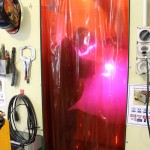 We now have engineering, auto engineering, welding, horticulture and farming training. The job uptake by our students is 97%. They know if they stay home and don’t attend someone is ready to take their place.
We now have engineering, auto engineering, welding, horticulture and farming training. The job uptake by our students is 97%. They know if they stay home and don’t attend someone is ready to take their place.
I have many more examples: Local Communities like mine have that community determination; Councils like mine have the ability to create partnerships with industry, such as what we did with Fonterra’s new $385 million milk drier, the Blue Pacific Minerals expansion, John Deere opening an engineering factory. There is the 50,000 hectares of forestry conversions that have been done using best farming practices and have brought more than 90 new families into the District.
So we can do, but how do we get Central Government to recognise that sub regional growth is taking place? Small communities like mine are making things happen because we have to if we are to maintain that which we treasure. I have had only one Cabinet Minster visit – he was in and out for the opening of the rail hub. Regional Growth they say is exploding but they mean Hamilton. We need recognition of sub-regional needs.
Encourage Local Councils like mine to be brave, courageous with their innovation and imagination. Encourage us, don’t wait and then say congratulations. As always finance is the biggie. Most of what we have done took more time than it should have as we had to justify every penny. We aren’t rich – far from it – so caution was the message, and frankly sometimes courage. We can do. Rural New Zealand can do, we all need to think local and let local do.
Saving more than the birds
By K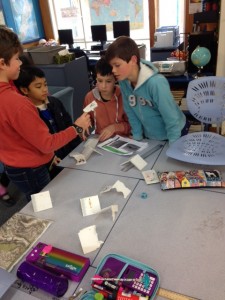 elvin Hastie – Crofton Downs Predator FreeI’m a guy who was out the front gate of his house and saw a stoat cross the road in front of him and decided to start Crofton Downs Predator Free Community as a means to alleviate my inner guilt and rage.
elvin Hastie – Crofton Downs Predator FreeI’m a guy who was out the front gate of his house and saw a stoat cross the road in front of him and decided to start Crofton Downs Predator Free Community as a means to alleviate my inner guilt and rage.
We decided to engage our place to become New Zealand’s first predator free community. Free of rats, stoats, weasels and possums. No one had ever tried this in a built up residential area, so we bonded the community together in a common goal.
We tend to think of these things as the birds and the reserves but we flipped that on its head and said let’s look at the community and ignore the birds.
We didn’t ask the experts how this could be done because we wanted to rewrite the rules without knowing what the rules were. We wanted to understand what the true barriers were and whey we were still going backwards in New Zealand when it comes to our environment.
I was keen to figure out what was most important: the outcome of trapping is more birds, lizards, invertebrates…..obvious right? Well no not really. We gave 500 hundred people a sense of PLACE and ownership in our small community.
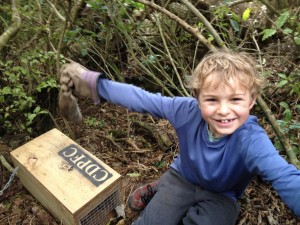 • We created community building and partnerships
• We created community building and partnerships
• A sense of purpose
• Exercise and wellbeing
• Connection to the environment
We gave our community ownership and they wrote the script.
We didn’t focus on an outcome, because often people want to jump straight to fixing what they perceive as the problem. In our case that would have been to jump straight into saving the birds by killing the predators, which is fun, but simplistic. The true outcome – which could be resolving a bigger problem is not always evident upfront, and that takes time to emerge.
On the 1st of November 2015 Crofton Downs was crowned NZ’s first Predator Free Community; free of rats, stoats, weasels and possums after monitoring zero. Some experts say to me this is not a true measure, it takes three years to declare an area predator free. So while this debate goes on – rather than wait three years to be declared predator free – we have widened the programme. It’s pretty hard to be predator free when your neighbours aren’t. We have expanded to four neighbouring suburbs that will now encompass 900 hectares under residential control. And another 1,500 hectares under best practice linked reserve control with 1,000 DOC200’s (traps) from outside the Zealandia Café to Mt Kaukau in the North and our birds are flourishing.
We have also partnered with other organisations like Zero Invasive Predators (ZIP) who are on the cutting edge of predator control in this country.
Wha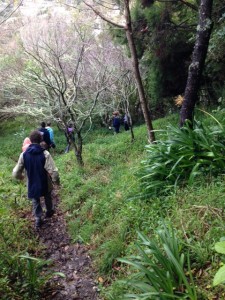 t happens when the predators are gone? Our community is finding new and wonderful ways to fill the gaps. People are becoming more responsible pet owners, people are watching over our Kaka fledglings as they drop on the ground, more planting is taking place and we are building new tracks and lining them with traps.
t happens when the predators are gone? Our community is finding new and wonderful ways to fill the gaps. People are becoming more responsible pet owners, people are watching over our Kaka fledglings as they drop on the ground, more planting is taking place and we are building new tracks and lining them with traps.
People are moving further into the landscape- walking, running, biking further, widening their aspirations and linking with our neighbouring communities to find out what else we can achieve.
If we adopt this way of working in communities I believe we will see:
• durability
• resilience
• woven aspiration and
• enduring regard
So while the battle for the birds continues across the wider landscape, we can all do our bit and every little bit no matter how small makes a big difference, it is no less important than the big bits.
Stone Soup – a mix of vision and action
By Judy Kumeroa, 2016
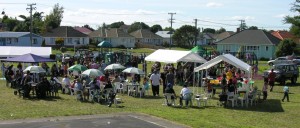 Te Ora Hou is based in Wanganui – we are a Maori, faith-based team, with six centres across Aotearoa, New Zealand.
Te Ora Hou is based in Wanganui – we are a Maori, faith-based team, with six centres across Aotearoa, New Zealand.
The foundation of our work is an initiative called Tiakina ō Tātou Tamariki (run in Gonville West, Castlecliff South in Whanganui and and Kaiti/Titirangi in Gisborne) and it’s all about leading change for ourselves. This story concentrates on Stone Soup in Whanganui but it includes what we are learning from both neighbourhoods.
Our neighbourhood was not functioning well in 2007. We had a low trust in services and a low trust in each other. We then experienced a trauma and the impact raged across the community. In that moment we were activated to think and to act differently. We began to share ideas, and that is how Stone Soup began.
Stone Soup is a folk story from Eastern Europe – the philosophical point of the story, which is key to our place, is the belief that each person in our community has something of value to offer.
Stone Soup is a mix of things based around a vision for a peaceful, connected, caring community.
It’s a community room based at a local school. It is a bunch of great ideas that we try; such as a craft group, a walking group, Stone Soup radio station, Growing Gardeners and community dinners.
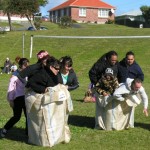 It’s a gathering we hold every two months at the local park, led by residents and others passionate about our collective capacity.
It’s a gathering we hold every two months at the local park, led by residents and others passionate about our collective capacity.
It’s a table at the gathering to sit around and talk about what’s hot, what’s not and what we want to do about it.
These are courageous conversations, sometimes making ourselves vulnerable to each other. We talk about child safety, speeding cars, bullying. We celebrate success from sobriety to the birth of a child.
We’ve acted on about 10% of the ideas generated from the korero across these activities including:
- Establishing a boys intermediate age youth group in response to concerns about unhealthy behaviours.
- Supporting three residents onto a school board to address community concerns.
- Developing a Driver License programme
- Supporting a woman to become a licensed Zumba teacher in return for one low cost Zumba class a week.
We’ve also developed an intentional conversation about family violence, the dynamics, and the various support residents can provide.
Empowering each other and taking steps to be an activator in your community is not a linear process! There are four key learnings that I hope you will find useful:
Enable people’s voices to be heard
The importance of this is illustrated in the journey of one of our neighbourhood mothers. Her family has a long history with services, and up until recently her children were under CYF care. She came to one of our park gatherings and after encouragement from us told her story, mentioning eventually that she was an alcoholic who had been sober for nine months, so things were going well for her. She told everyone if she could do others could also. This mother is now qualified in elder care, she got her first job, at 37 years. Her children are back her care, she is still alcohol free and she has found her voice.
Work with who you have
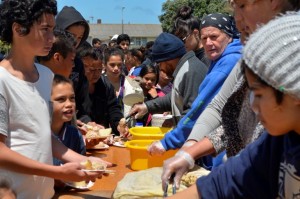 The impact of harmful, criminal gang behaviour had been one of the community’s biggest concerns, lives were being lost. After a number of korero our approach settled on inviting everyone to be part of the Stone Soup journey. The behaviour of one group was particularly challenging but over time their senior leadership articulated an aspiration for a better quality of life for their whanau. We are quietly encouraging that group, offering support to individuals at levels they can accept It’s a long term journey. Gang behaviour was not a top concern in our 2016 neighbourhood survey. This doesn’t mean all harmful behaviours have changed but we see change happening.
The impact of harmful, criminal gang behaviour had been one of the community’s biggest concerns, lives were being lost. After a number of korero our approach settled on inviting everyone to be part of the Stone Soup journey. The behaviour of one group was particularly challenging but over time their senior leadership articulated an aspiration for a better quality of life for their whanau. We are quietly encouraging that group, offering support to individuals at levels they can accept It’s a long term journey. Gang behaviour was not a top concern in our 2016 neighbourhood survey. This doesn’t mean all harmful behaviours have changed but we see change happening.
Practice Sugar-Free Story Telling
It’s tempting to sugar-coat our story, to make our stuff look better than it is. To roll out the successful achievements in a blaze of glory, to hide the unimpressive stuff, to simply deny the existence of the failures.
We were mindful of this trap and turned to Inspiring Communities to help us carry out a survey to measure change. The results were not that flash – the change we thought we’d seen wasn’t strongly backed up by data. We were gutted. We asked I C’s Denise Bijoux to ask us the interrupting, critical and hard questions to trigger ideas – think with fresh eyes. Having someone outside our community ask those hard questions has been valuable.
Understand Effective Funder Relationships
We’ve had funders join us along the way. A genuine high trust relationship, multi-year funding or cross-funder arrangements, feeling safe to tell the stories of failure and accountability reporting that captures stories of change are what we value the most.
Substantive relationships with supportive funders who are open to new approaches, has enabled us to shift our focus from filling funding gaps to focus on the vision of change we have – this is a Community Strategic Plan.
More information: teorahou.org.nz
Small Village, Big Vision
Te Kowhai is a small village north west of Hamilton. There’s a green grocer, a dairy and a take-away which is only open three nights a week for two hours.
But behind this seemingly small façade is a big history, a strong community heart and a quiet determination to make Te Kowhai an even better place.
Made up of around 720 households, Te Kowhai is a rural community of largely lifestyle blocks and farming families. At the heart of the village is a thriving community kindergarten and primary school for the village’s 321 students which features state of the art classrooms with activity-based learning spaces, and a digital strategy target of 1:1 device:child ratio.
A unique feature of Te Kowhai is that, unlike many other semi-rural areas within the greater Waikato, the village is growing – and fast.
Connecting Te Kowhai to the Waikato District Council and its wider community is a small group of dedicated residents and local business owners who have formed the Te Kowhai Community Group. Chaired by Daryl Smart, the group’s objectives are to actively enhance lifestyle and amenities in the area.
This small group of locals meet monthly to progress key local projects, all managed voluntarily, and funded by donations and various public and private grants. They’ve made some huge improvements to the area over recent years, including:
- Installation of flashing speed alert lights to slow traffic around the school.
- Undergrounding power and telephone lines in the village.
- An extension and modernisation of the community hall.
- Re-establishment of native trees (especially kowhai) throughout the village, its parks and gullies.
- The establishment of a cricket ground.
- School bus pick-ups for nearby high schools.
One of the Village’s most significant projects to date has been the reclamation and regeneration of the Te Otamanui Lagoon – a wonderful, but hidden asset! Featuring a 60 acre lake with a 3kilometre long gully, the lagoon has been a key focus for some long-term thinking and action. Keen to enhance the lagoon and future-proof local walking and leisure requirements for the next 100 years, locals developed a plan that initially seemed exceedingly ambitious. Now however, it looks imminently achievable.
Core to the vision for Te Otamanui is a 6-10 kilometre walkway, starting in the centre of the village and following the Te Kowhai Stream and Te Otamanui Lagoon to the Waipa River, lined by avenues of flowering Kowhai. The Te Kowhai community has led the walkway’s development, with progress depending entirely on the generosity and goodwill of the many landowners, and sheer grunt work of local community groups and volunteers.
In March 2015, a second section of the Lagoon walkway was opened to the public. Local resident (and driving force behind the project) Graham McBride originally believed that the walkway wouldn’t be completed in his lifetime but is having to fast readjust his views!
Upgrading the area’s broadband capability is another current priority for Te Kowhai.
To discuss what could be done, a special project group was brought together that included representation from the local retirement village, school, businesses and local residents. In talking together, the group realised there was a hardware problem with their infrastructure causing severe connection problems for everyone accessing the internet. Talking and working together on an upgrade proposal meant the group was able to identify the size of the problem and approach the big companies to help Te Kowhai do something about it.
As a result, Chorus have come forward to upgrade the area’s IT, meaning the central village will have access to VDSL-speed broadband. There are ongoing plans to improve access into adjoining rural areas also.
Pivotal to these big successes for this tiny village is the community’s ability to communicate with residents. Every two months the district produces a newsletter which is funded by advertising from local small businesses and voluntarily edited and produced by Te Kowhai Community group member and local resident Amanda Schaake. Amanda notes just how important the newsletter has been their community’s progress.
“We use the newsletter to let people know about the Te Kowhai Community Group’s projects and what’s happening. The more involved people are, the stronger our community will be so we try to bring people together as much as we can through working bees, progress meetings, and Community Group events. The newsletter and its email circulation list are critical tools to help us reach people.” With more than 120 residents now connected via the Neighbourly website, new online ways for Te Kowhai residents to connect and engage with each other emerging too.
With such a strong sense of community spirit and belief in what’s possible– this small village can only continue to achieve big things.
by Amanda Schaake, Editor Te Kowhai News
For more information take a look at the Te Kowhai Community Group’s Facebook page:

